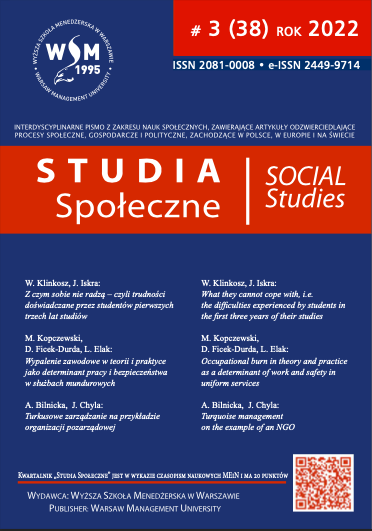ZABURZENIE NAPADOWEGO OBJADANIA SIĘ I JEGO PRZEBIEG. PRZEGLĄD LITERATURY DOTYCZĄCY NIEDIAGNOSTYCZNYCH CZYNNIKÓW ZWIĄZANYCH Z ZABURZENIEM
BINGE-EATING DISORDER AND ITS COURSE.
A LITERATURE REVIEW ON NON-DIAGNOSTIC FACTORS ASSOCIATED WITH THE DISORDER
Author(s): Karolina Lewandowska, Waldemar Klinkosz, Wojciech StykSubject(s): Clinical psychology
Published by: Menedżerska Akademia Nauk Stosowanych w Warszawie
Keywords: eating disorders; binge-eating disorder; anger expression; anxiety; self-ef- ficacy; body image;
Summary/Abstract: This work is a literature review on binge-eating disorder (BED) and non-diagnostic fac- tors associated with this disorder, such as anger expression, anxiety, self-efficacy, and body image. Binge-eating disorder includes recurrent episodes of uncontrolled eating, not related to physical hunger, and these episodes are accompanied by high mental costs. Current research highlight the psychological complexity of this disorder. Resear- chers suggest that people with BED recognition are a separate subgroup among obese patients, because they show an unique clinical profile that is associated with a higher psychopathological intensity. Increased psychopathology most often concerns affecti- ve disorders, impulsivity, mood disorders, and body dissatisfaction. Binge-eating people feel anger and anxiety more often than those who do not experience binge-eating. Moreover, patients diagnosed with BED experience lower self-efficacy, but research re- sults in this field remain ambiguous. The anxiety related to the body among patients with BED is similar to the anxiety experienced among patients with bulimia. Due to the limited number of research on the relatively new problem which is binge-eating, it is necessary to develop knowledge in this area.
Journal: Studia Społeczne
- Issue Year: 38/2022
- Issue No: 3
- Page Range: 51-70
- Page Count: 20
- Language: Polish

